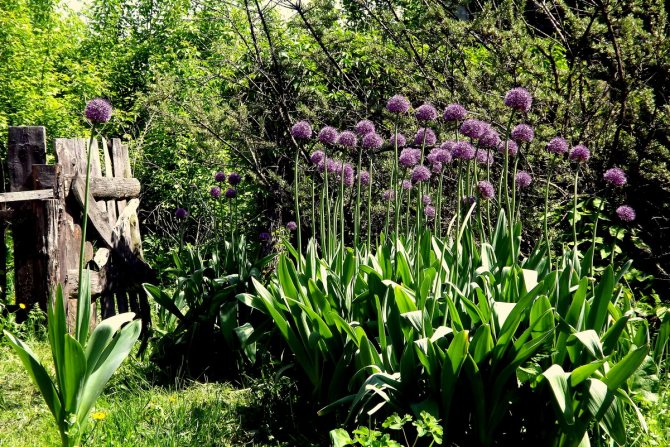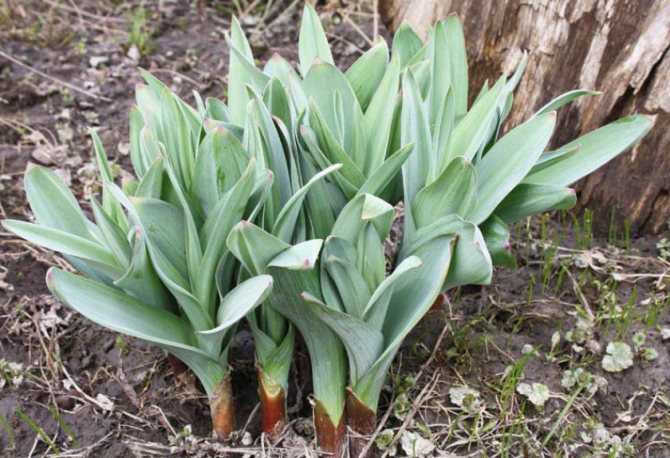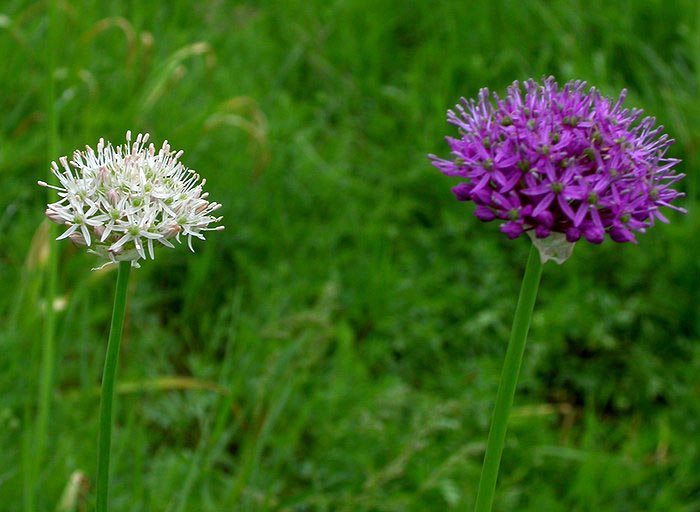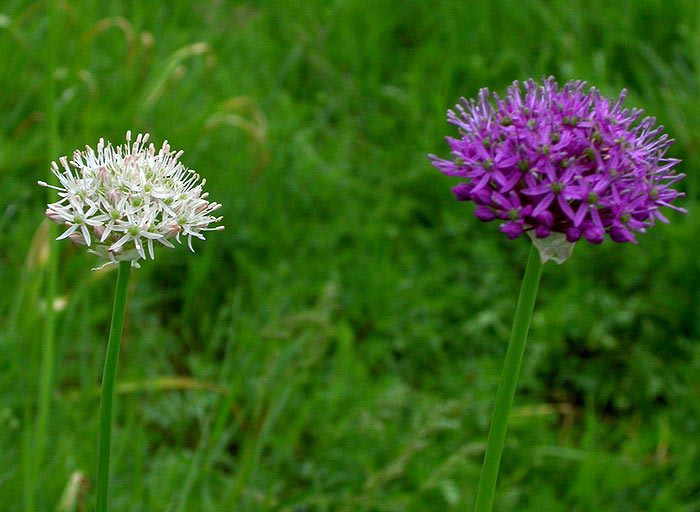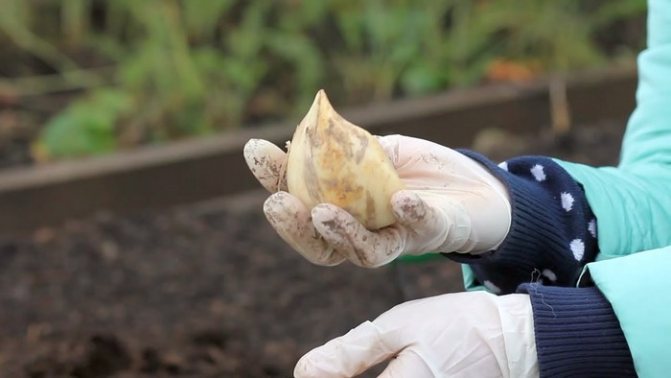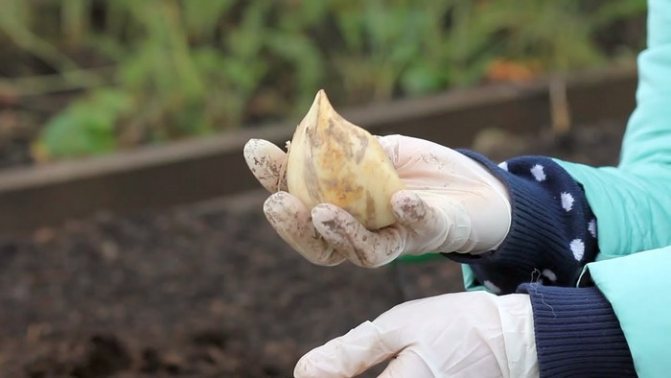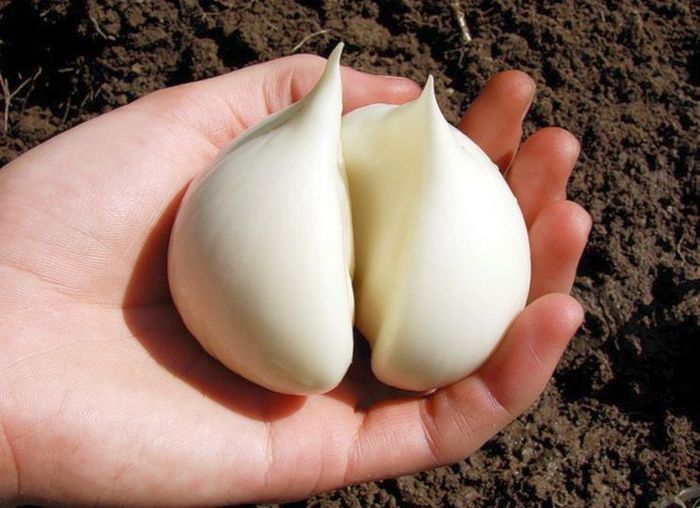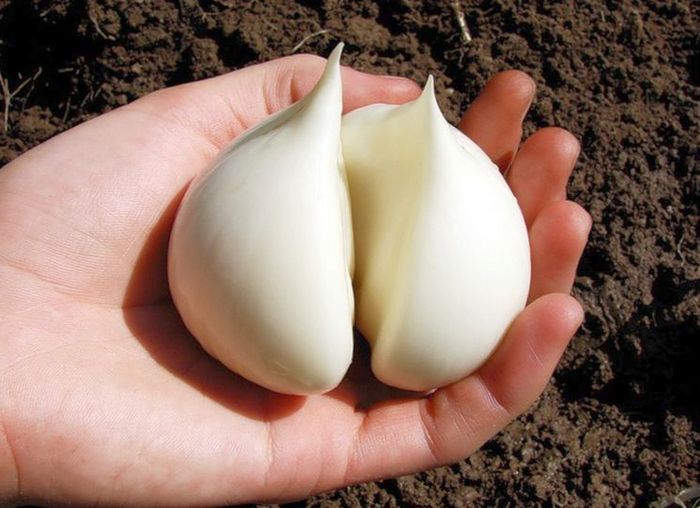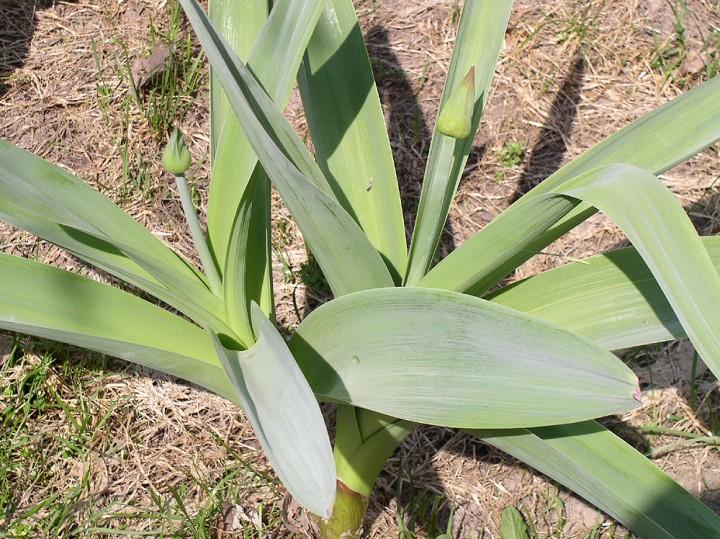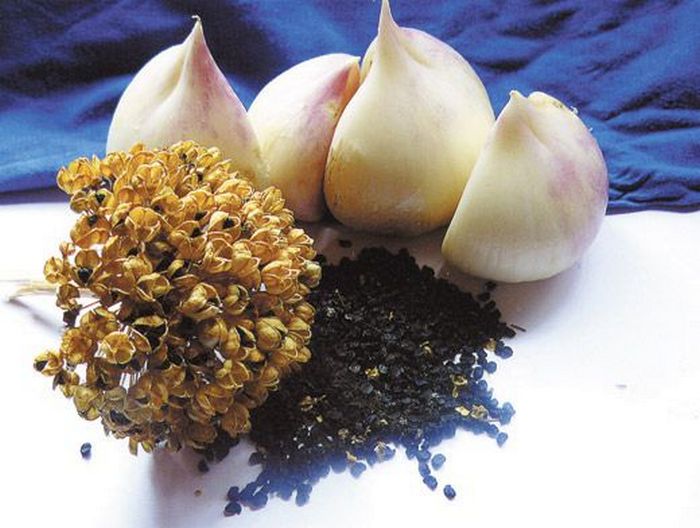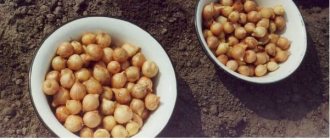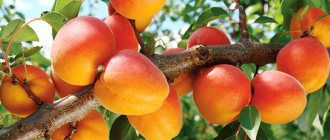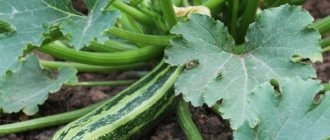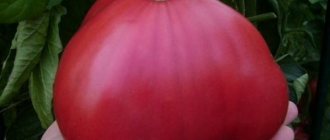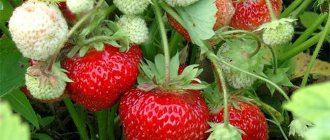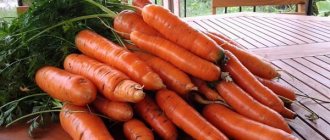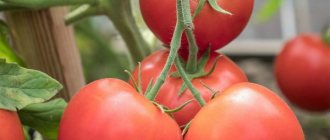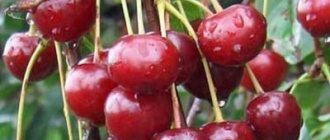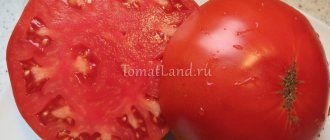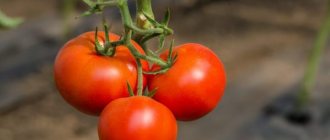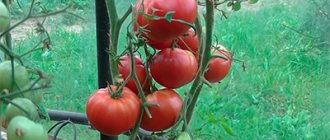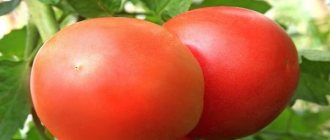Description and characteristics of the variety
The plant is not very well known in the European part of the country, since its habitat is located in the mountainous regions of Asia - in the Tien Shan and Altai. The plant is difficult to compare with anything - the shoots of a young anzur resemble tulips, later, as they grow, these bushes become like a very large garlic.
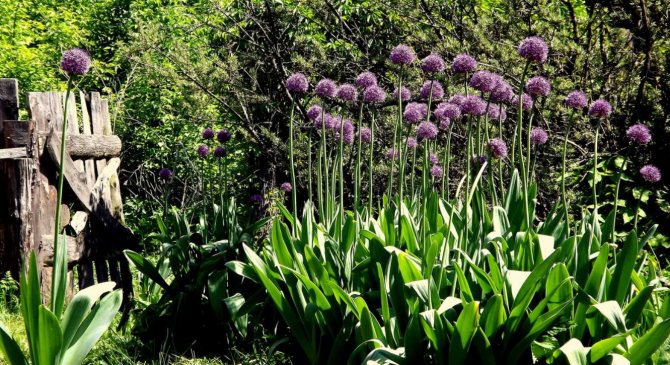
The leaves of this onion reach a length of 35 cm, and the arrows can stretch up to almost one and a half meters and end in spherical purple inflorescences with a diameter of about 10 cm.The bulbs are large - up to 12-15 cm in diameter, ripen by mid-summer, like the fruits in the inflorescence. Each box on the arrow contains up to three seeds.
Biological features
Suvorov's onion is a type of garlic that belongs to the onion family. Several similar species are united by the common name Anzur, which local residents have called wild plants since ancient times. The homeland of Suvorov's bow is considered to be the mountainous regions of the Pamir-Altai, Tien Shan, and the Syrdarya gorge.
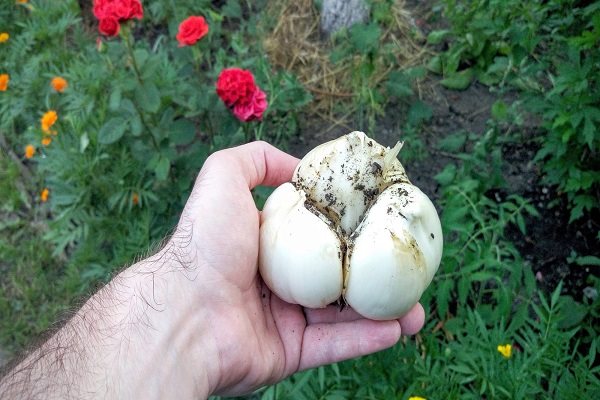

Distinctive features of the plant are formed by the natural growing environment. The highland areas are characterized by severe winters with thaws and hot summers with sharp temperature drops at night and during the day. Favorable conditions for growth occur for a short period from the moment the snow cover melts to the onset of the summer heat:
- Anzurs have time to grow and form seeds in a short period of 2–3 months.
- Plants have a well-developed root system, adapted to the conditions of stony ground.
- High peduncle and bright spherical bud 6–8 cm in diameter, which is an excellent honey plant.
- The active growth process begins already at an air temperature of 2–5 degrees and the soil warms up at a depth of 10 cm to positive values of 1–4 degrees.
- Garlic is characterized by a rapid change in growth phases, and with the onset of the dry period, it passes into a stage inside the bulbous development.
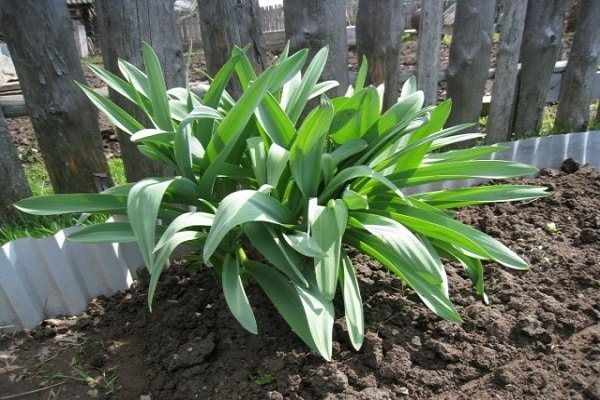

High-mountainous garlic tolerates winter cold, hot dry periods, shade-tolerant. Plants are flexible, adapt well to new conditions, are not damaged by diseases and pests. The biggest problem for the Anzurs is acidic and waterlogged soils, and stagnant waters can completely destroy garlic.
Properties of the Suvorov bow
Like any fruit, the bulb of this plant has its own useful and harmful properties. Given the medicinal data, such an onion can be used for many diseases.
Important! The fruits of the plant are used in pharmacology as part of many drugs, since they contain alkaloids and steroids.
Benefit
Suvorov onion contains nutrients in much larger quantities than classic vegetables. It is especially rich in vitamin C, and the leaves have a high content of vitamins B, E and mineral salts.
- The healing properties of the bulbs are as follows:
- anesthesia;
- activation of brain activity and improvement of memory;
- strengthening of immunity and metabolism;
- help in the treatment of diseases of the respiratory system;
- fight against diabetes mellitus.
In addition to useful properties, anzur is perfect as an ornamental bush. Also, the plant is frost-resistant, early maturing, successfully resists diseases and harmful insects.
Harm and contraindications
As in the case of other useful inhabitants of the beds, this garlic onion has some contraindications for use that can harm the human body.
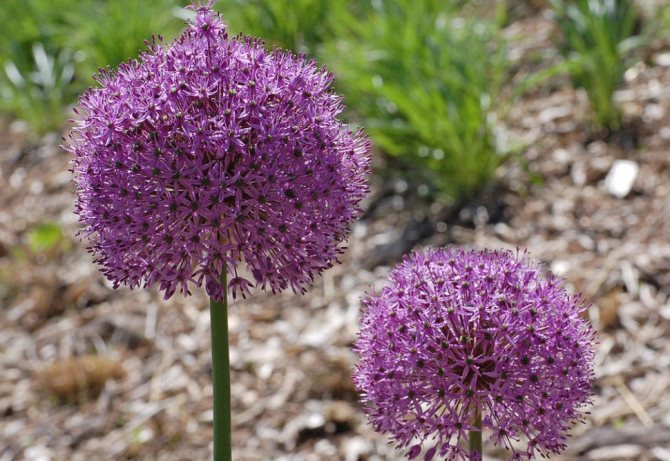

First of all, you need to know that raw bulbs are poisonous, so they must be heat treated. The first shoots should be used for food while they are at a tender age, since the leaves quickly become tough, lose their nutritional qualities and become unpleasant to the taste. It is undesirable for allergy sufferers to take greens and fruits, since the body's reaction to an unfamiliar product may be unpredictable.
Description of the plant
The bows of Anzura are similar to each other, but small differences still exist:
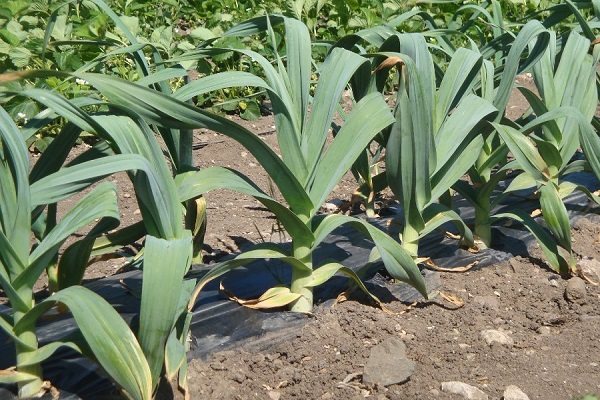

- The Suvorov bow, unlike most Anzurs, has a spherical onion with a diameter of 6–8 cm.
- The integumentary membrane is leathery, grayish, firmly grasping the base of the stem.
- The leaves are narrow and 5–8 cm wide, rough along the edge, green with a bluish bloom, 40–50 cm high.
- The peduncle reaches a height of 1–1.3 m. The inflorescence umbrella is multi-flowered (from 100 to 300 flowers), very dense, has the shape of a ball with a diameter of 7–12 cm.
- Lily flowers with a blunt tip and a length of about 4 mm, are colored purple.
- the fruit looks like an egg-shaped capsule with black triangular seeds.
See also
The benefits and harms of white onions, varieties of varieties, storage and harvesting rulesRead
The onion grows in a bush, forming a powerful rosette from the leaves. Like all alpine onions, Suvorov garlic belongs to ephemeroid plants, with a very short growing season and a long dormant time. In this he is similar to tulips and daffodils. Even outwardly, at the initial stage, the plant is very similar to tulip seedlings. As it grows, the mountain onion changes and looks more and more like a giant garlic.
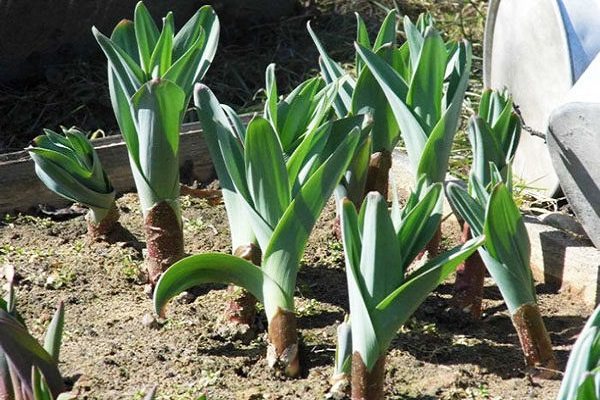

Important! Ephemeroid species of mountain onions, with a very short growing season, are listed in the Red Book of Uzbekistan, due to the danger of complete extinction.
Growing methods
Soil cultivation of Suvorov onions is possible both by seed and vegetative methods. The first method is much more complicated - obtaining high-quality material is possible only with proper plant care. This does not always work out - it's just an onion, as many gardeners believe, therefore, they do not provide special care for the plant, letting everything go by itself.
Important! As with the cultivation of regular onions, the arrows of the Anzur can be broken off before flowering. Thus, all nutrients will be preserved in the bulbs.
Seed
To obtain high-quality seeds, it is necessary to provide the bushes with full-fledged care and be patient - the bulbs will be able to grow only after four years. Growing from seeds involves the production of frost-resistant bushes, the seeds for which are planted in the fall.
Vegetative
Growing from daughter bulbs is much easier and faster - the first harvest can be obtained already in the year of planting. However, it will not be of the same quality as painstakingly grown from seeds. The vegetative method is suitable for quickly getting onions for sale.
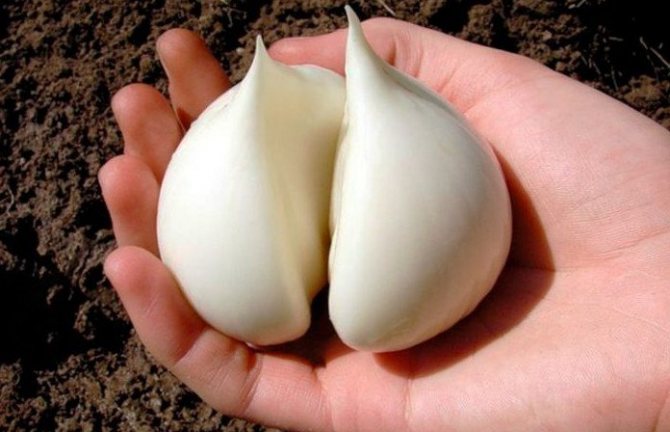

Seed propagation
Growing Anzur from seeds is a very long and painstaking process, in which the first harvest can be obtained only after 3-4 years. After collecting seeds from an adult plant, you need to proceed with the following steps:
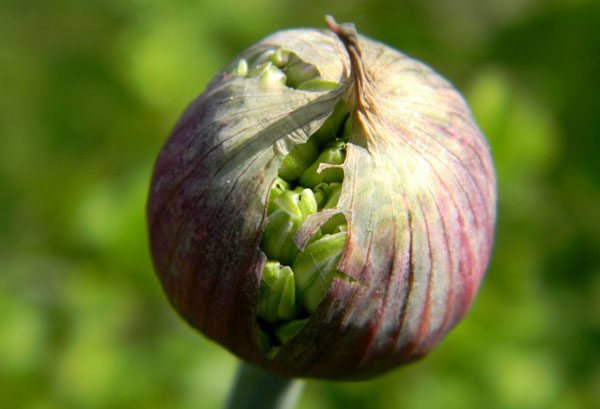

Peduncle of the Suvorov onion with seeds
- at the end of October build beds 10-12 centimeters high;
- seeds deepen 1.5-2 centimeters;
- then landings harbor 2 cm layer of peat or humus.
The first friendly shoots can be seen in late March - early April.
After the one-year-old plants release the cotyledon leaves, they begin to dry out and form tiny bulbs. They must be dug up, dried and left until autumn.With the onset of the right time, the bulbs are planted at a distance of 5 centimeters from each other, the distance between the rows will be 25 centimeters. Embedding depth - 5 centimeters ... Such work is repeated twice. At the 4th year of life, it can be planted in the traditional way.
How to grow at home
The selection of high-quality planting material and the implementation of recommendations for planting and cultivation give high chances of getting a good harvest.
Optimal timing for planting
The frost resistance of this onion allows it to survive the winter cold well and to sprout already in the first sunny March days, even before the snow melts. When to plant both seeds and bulbs or slices of them, the gardener determines depending on the weather conditions. This is usually done in the middle of autumn, when the ground has already a little rest from previous crops, but has not cooled down too much.
As part of the correct crop rotation, before cultivating anzur, crucifers, cucumbers or potatoes should grow on the site. Late vegetables are undesirable, since the soil exhausted by them may not have time to recover even with the use of dressings.
We advise you to read about growing and caring for chives.
Selection and preparation of planting material
Considering the long terms of growing fruits from seed material, it is worth considering carefully the choice of seeds for planting. The material is sorted out, dried and unhealthy seeds are discarded. Then they are soaked in a weak solution of potassium permanganate. It is better to remove floating grains.
For good germination, you can apply such a well-known method as scarification - seeds or bulbs are deliberately damaged to accelerate the emergence and emergence of sprouts. This is done with sandpaper, coarse sand, or sharp instruments. When grown vegetatively, large bulbs are divided into several slices - in a way, this is also scarification.
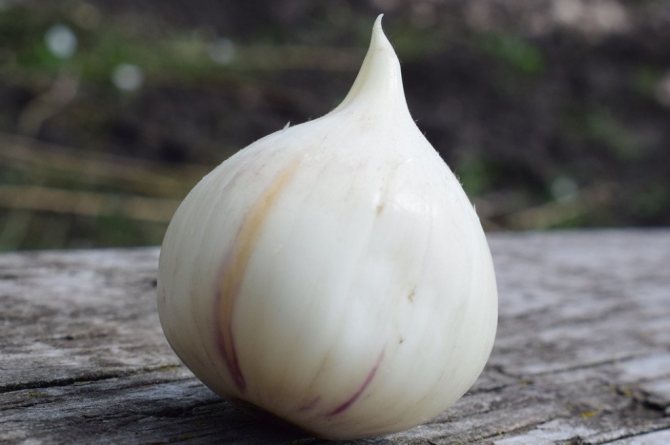

Growing conditions
The temperature regime for the Suvorov onion is not too important - resistance to cold allows it to grow normally in rather harsh conditions. The short growing season of edible shoots (from two weeks) makes it possible for them to “catch up” before the hot season.
The moisture for the plant is quite natural, since the fleshy stems and the bulb are able to retain moisture to the required degree. That is why you should not get carried away with watering, only occasionally moistening the soil around the plant during dry periods.
Anzuru really likes spring sunny days - when the soil has not yet warmed up, or even there are remnants of snow on it, the bushes grow at such a speed that during the day it can be traced with the naked eye. In the event that the bow was planted late or was late in development, it is better to shade its arrows with an agro mesh to diffuse lighting.
Planting the Suvorov bow
In order to get the harvest as early as possible and not engage in painstaking work related to the construction of seeds, experienced gardeners recommend planting the Suvorov onion using bulbs or slices... To obtain high-quality planting material, it is dug out of the ground until the leaves are completely dry.
Given the good frost resistance of the variety, it is necessary to plant it in open ground in the fall. If work is carried out in September, then the fruit will be divided into 4-6 cloves; with a later planting, the division will not be so intense.
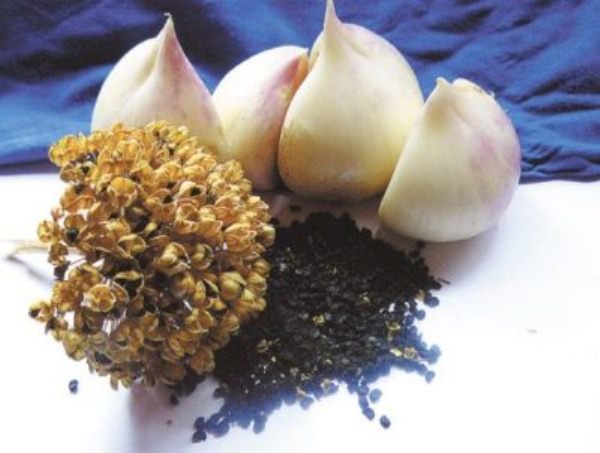

Suvorov's onion is propagated by cloves and seeds
When preparing the beds, it is necessary to take into account all the features of the plant being grown:
- The best thing grows on loose, sandy loam soils... In clayey soil, there is a high risk of fungal infections;
- Many gardeners claim that such a culture will grow well in those places where did cucumbers, potatoes or cabbage grow before it?;
- It is better to make the beds in bulk, such a procedure will help to avoid waterlogging;
- Not worth planting in places where precipitation and melt water accumulate;
- Before boarding the earth is thoroughly loosened and cleared of weeds.
Basic rules of care
Suvorov onion is an undemanding plant, but following certain care rules will help to grow a much larger crop.
Irrigation rates
As mentioned above, the main growing season of a plant occurs in spring, when the soil is still saturated with moisture after snowmelt. In the future, you need to monitor the state of the layer below the upper one, if necessary, carry out moderate moistening, avoiding stagnation of the liquid.
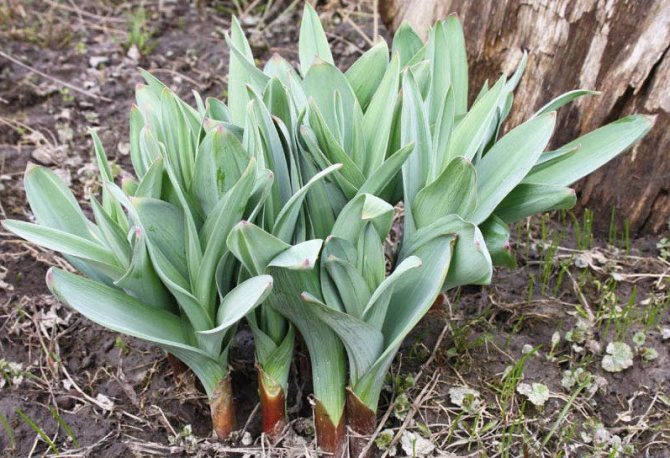

Loosening the soil and weeding
Light and loose soil is well accepted by the plant, and it develops well in it. After the snow melts, rain or watering, you need to loosen the earth, raking it to the stem.
It is necessary to weed any weeds that have begun to grow in the aisles or near bushes. Thus, it is possible to exclude the weakening of the soil and direct all the forces of the onion to growth, and not to regain its "place in the sun." You also need to remove all weed roots from the soil, as well as their remains, which have already begun to rot.
Top dressing
When the first leaves appear, anzur is fed with urea, ash and nitrogen fertilizers. Potash fertilizers can be added twice during the growing season, from which the plant shoots arrows well and forms bulbs.
conclusions
Thus, any even a novice gardener can plant Anzur onions and enjoy them not only for medicinal and culinary purposes, but also as a beautiful plant that will bloom in late spring or early summer.
It is not difficult to obtain seeds or slices for further propagation of this type of onion, since up to four new bulbs can be obtained from one slice. And the number of seeds that shoots from each plant turns out to be very large.
If you use all useful plants during the calendar year, based on their ripening periods, you can stock up on vitamins for the remaining months. This article will tell you about other decorative onion varieties.
Diseases and pests
Pests bypass any type of bow, and Suvorovsky is no exception. But diseases, in the form of various rot and growth disorders, may well appear under the wrong growing conditions. Excess moisture leads to rotting of the bulb and stem, lack of illumination brightens the arrows, heavy soils reduce yields and lead to shredding of the shoots.
The main method of prevention is the high location of the garden. For significant lesions, fungicides (eg Bordeaux liquid) can be used.
Video: Bow of Suvorov (Anzur)
Advantages and disadvantages
The Suvorov bow is not yet very common on the territory of our country. However, gardeners who have tried the culture are sure that soon it will be grown in every garden due to its many advantages.
The advantages of the variety:
- intense taste: outwardly, the shape of the bulb strongly resembles garlic, which can be said about the taste characteristics. The product is ideal for preparing a seasoning that adds spice to any dish;
- rich in vitamin composition: the product is saturated with vitamins necessary for bones and blood. By consuming a sufficient amount of onions, you can support the body during a period of seasonal lack of useful elements;
- early ripening period: in the beds it appears faster than the rest of the greenery;
- resistance to negative factors: severe winter and various diseases do not affect the quality of the onion.
Disadvantages:
- young greens quickly become unusable due to rapid growth and coarseness;
- onions are edible only after heat treatment;
- moisture intolerance;
- not recommended for allergy sufferers, as it can cause an unpredictable reaction.
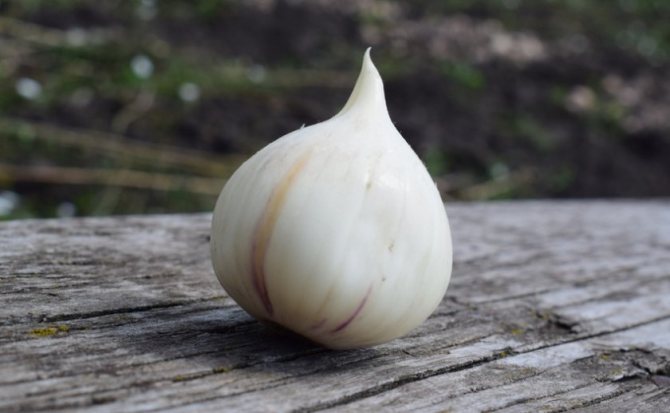

Anzur onion is rich in vitamins C and D
Harvesting and methods of using the crop
Young arrows are cut and used as components of salads or simply salted and used for food. Ripe bulbs are carefully dug up and sorted for future planting or for eating.
For the uninitiated, the question often arises whether this fruit is edible or not. It is not only edible, but also has many beneficial properties. As it is, you can consider the example of garlic - what it is known to everyone, you just need to use it as a seasoning for the main dish in a small amount.
Did you know? Anzur is best used in food pickled or baked. Before that, the fruits need to be soaked in water for about a month. Even after such processing, you need to eat it in small portions, like any other delicacy.
The use of Anzur onions in cooking
Many gardeners prefer to grow Anzur as an ornamental plant, despite the fact that its foliage and bulbs are very edible. The bulbs are unusual in taste. They are a mixture of radish and garlic. The bulbs have a pungent sulfur smell.
Suvorov's onions are rarely consumed in food without processing. As such, it can do more harm than good. Before processing, it must be soaked, and then Anzur can be cooked by boiling with honey, baked or pickled. For soaking, the bulbs are dipped in water, it is possible with the addition of table salt, changing it the required number of times until the smell disappears.
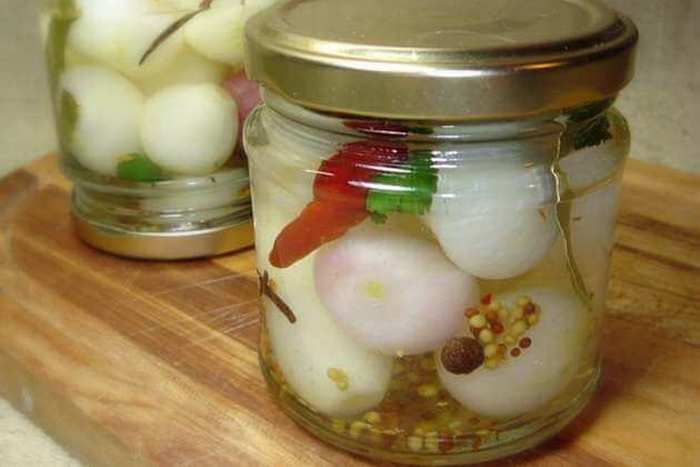

Cooking Anzur onions
Mineral salts and vitamins that are contained in young Anzur leaves, useful and juicy, cause their frequent use. They are sometimes compared to ginseng because they have such a beneficial effect on the human body.
You can make sandwiches with them, prepare salads, as well as soups or cabbage soup according to original recipes. If there is a desire to save the leaves for use after a while, they are frozen, otherwise they quickly coarse.
On a note. Crop-launched arrows in early spring are used to prepare vitamin salads. In Asia, pilaf with Anzur is a fairly popular dish.
Anzur is primarily valued because of its medicinal properties. With a whole spectrum of diseases, it can be applied. Suvorov's onion improves the functioning of the brain, memory, enhances immunity and simply tones the consumer.
Landings with Suvorov onions may seem unusual to many, and the fruit itself cannot be attracted by the tasty bulbs that ordinary onions have. However, taking into account its healing effect, as well as simple care for the plant, it is quite possible to plant it in your summer cottage.
The healing properties of anzur onions were tried by the army of Suvorov. The warriors were able to recover from scurvy and maintain their combat effectiveness precisely thanks to this plant with a high flowering stem and globular purple inflorescences. The bulbs contain such biologically active substances as phytoncides, mineral salts, carotenoids, saponins, ascorbic acid, vitamin E, D, C (the content of the latter is several times higher than in onions).
It is believed that such a plant can slow down the aging process and help older people get rid of the "bouquet of diseases" that have piled on them. Anzur onion is a medicinal plant that helps to improve hearing and vision, and can relieve dizziness. When baked, in combination with honey and milk, it solves the problems of colds and stomach diseases.
Fresh leaves of Suvorov onions are most often used in cooking - they are added to okroshka, salads, soups, meat dishes
Unfortunately, on the territory of Russia (unlike the Caucasus, Transcaucasia and other countries) the onion variety in question is not particularly popular. Connoisseurs of Suvorov's onions are sure that this is due to a lack of understanding of the full value of this product.
Due to its piquant taste and delicate aroma, Suvorov onions are actively used in cooking. In early spring, when the plant shoots arrows, they can be plucked to prepare the first spring salads. They can also be a great addition to meat, soups and other dishes.
Onion heads are actively used for the preparation of preserves and marinades. In some cases, the heads themselves are pickled (a particularly popular dish in Uzbekistan is pilaf with pickled anzur).
Suvorov's bow has also found its application in folk medicine. Juice, gruel (only from boiled product) with the addition of honey are prepared from onions. In addition, Suvorov's onion is a component used in pharmacology for the manufacture of certain drugs.
Suvorov's bow will help prevent the development of diseases of the hearing organs, genitourinary system, dermatological problems, gastrointestinal diseases, colds, etc.
Attention! If you suffer from any of the diseases of the cardiovascular system, you should refrain from using Anzur not only for medicinal purposes, but also as an element of food.
Useful advice from gardeners
Despite the small popularity of the culture, sufficient experience has been accumulated in its cultivation.
Here are some guidelines for beginners:
- it is better to cut the leaves at the most tender age - they can perfectly complement sorrel in borscht or add a variety of flavor to spring salad;
- during planting of the bulbs, you must not damage the root tubercles;
- when the roots rot, it is necessary to plant a bush from a common garden for several days, if it does not recover, then it is destroyed;
- arrows with blooming purple balls can be cut not only to improve the formation of bulbs - they will stand in a vase for several weeks, delighting with a spectacular appearance.
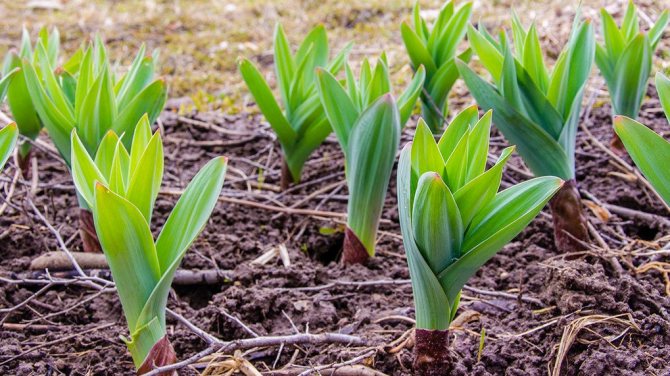

Suvorov's onion is known only to a few gardeners, but they have long studied how it is grown and eaten. Under natural conditions, the growing area is quite small, but successful cultivation already brings this plant to the category of useful for humans. You just need to pay attention to the fact that under the beautiful purple cap of the inflorescence, there is an onion in the ground - a whole storehouse of useful substances.
Agrotechnics
Anzuruvoro bow includes 3 types of bows:
- Stalked onion;
- Giant view;
- Suvorov's bow.
Not everyone who sees this plant for the first time immediately understands what kind of culture it is, and whether Suvorov's onion is edible or not. In biology, Anzur refers to mountain bows. One of the important advantages of the Suvorov onion is undoubtedly its resistance to cold weather, it can endure very frosty winters without loss.
The culture has rather large leaves, which reach a length of 35 cm. The arrows of the onion stretch up to 1 m.The inflorescences are balls with a purple tint, the diameter of which is about 10 cm.
Suvorov onions need loose soil and sandy loam composition. If the soil contains a lot of clay, there is a possibility that the onion will rot due to fungal infection. It grows well where there were cucumbers, cabbage or potatoes before it.
On a note. The beds for the Suvorov's onion, or as it is also called the Anzur onion, are specially poured in order to prevent the accumulation of water as a result of melting snow or precipitation. The bulbs do not need too much waterlogging.
Anzur onions are planted in areas with an abundance of sunlight, open and airy. As with many other crops, the soil has been prepared for it since the fall. The preparation consists in harvesting what is left of the harvest of last year, as well as removing the roots, which are taken to the place of burning.
Growing
For reproduction of the Suvorov onion, there are two options:
Planting Suvorov's garlic onions with seeds is not used so often, since it implies a long wait for the formation of large bulbs, which is 4 years. Seeds can be obtained easily, the plant produces in abundance as an adult.
Seeds of Suvorov garlic are sown in the fall just before winter, when frosts are about to come. The beds are raised, but not too high, and the seeds are planted 2 cm deep. A prerequisite is mulching using humus and peat. This is all the more necessary if the ground at the landing site is heavy. The Suvorov bow will rise in the spring. This will happen quite early, in the month of March or at the very beginning of April.
Types: Giant, Suvorov, Aflatunsky
Their main differences are in the shape and size of the bulb, the form of inflorescences, and the shape of the leaves.
Read about the onion root system at the link.
For example, the Aflatunsky variety has an ovoid bulb reaching a maximum thickness of 6 cm. The inflorescence of this variety is obtained in the form of a spherical umbrella. And the petals have a sharp tip and their maximum length is 7-8 mm. After this umbrella has faded, it falls off. The seeds are contained in a capsule, about 5 mm in diameter.
The giant onion variety has a bulb similar to the Aflatun variety, and its leaves are more gray-gray. In general, it is more similar to the Aflatun variety. In a stalked onion, the bulb is more flattened, up to 7 cm in diameter. The leaves are flat and wide, reaching a length of up to 50 cm. The inflorescence is also in the form of a globular umbrella of dark lilac color.
In general, all these types are similar to each other, therefore they are combined into the general appearance of the Anzur bow.

